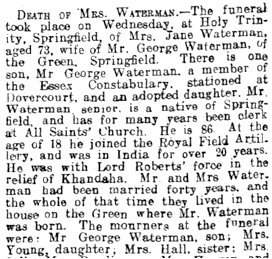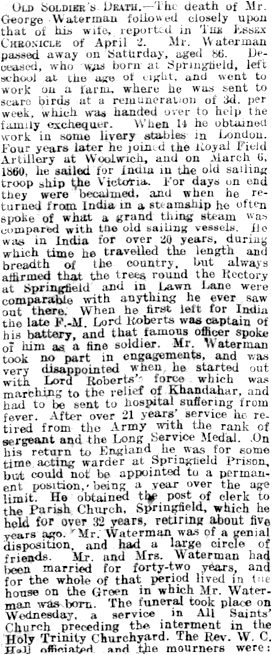Wilfred Arthur Waterman was born and raised in Springfield, the son of a career soldier. He was educated at Chelmsford’s Grammar School and later worked at Marconi’s factory in the town. He served in the army during the war and was killed in action on the opening day of the Battle of the Somme in July 1916. His home was in Springfield Green.
Wilfred was born in Springfield on 11th December 1893, the son of George Waterman and Mary Jane Waterman (nee Brown). His father had been born in Springfield in 1840 and had served as a Sergeant in the Royal Artillery before 1891; Wilfred’s mother had been born in 1853 in Aveton Gifford, Devon. The couple had married in 1884 in London.
Wilfred had one other sibling. an elder brother George Waterman (born on 31st August 1885 in Springfield, died in 1974). In 1891 the family had been living at 9 Springfield Green, Springfield, the home where Wilfred’s father had been born. WIlfred’s parents were to remain at the property until their deaths in 1926.
The 1901 census found seven year-old Wilfred living with his parents and elder brother George at 19 Springfield Green, Springfield. His family had lived at Springfield Green for decades. At the time of the census Wilfred’s father was church clerk, while his brother was a telegraph messenger.
Wilfred was initially educated at Springfield National School. On 18th September 1906 he joined Form III at King Edward IV’s Grammar School in Chelmsford as a day scholar. At the time his father was an army sergeant pensioner living at Springfield Green. Wilfred remained at the grammar school until 17th December 1908, when he left Form V, aged 15.
The 1911 census found Wilfred still living with his parents at Springfield Green. Wilfred’s army pensioner father was aged 71 and employed as Church Clerk, his mother 58, while Wilfred, then 17, was working as a factory clerk at Marconi’s in Chelmsford.
Wilfred lived and enlisted at Chelmsford and served with the 10th (Service) Battalion of the Essex Regiment., a volunteer battalion that was part of ‘Kitchener’s New Armies’. The battalion, formed at Shornecliffe in September 1914, was part of the 53rd Brigade of the Army’s 18th (Eastern) Division. The following month it moved to Colchester where training continued until May 1915. While in Colchester Wilfred married Lena Cooper.
In May 1915 Wilfred’s battalion left Colchester for final training at Codford-St.-Mary on Salisbury Plain in Wiltshire. On 25th July 1915 Wilfred, along with the rest of his comrades in the battalion was taken by train from Wylye to Folkestone for the trip across the Channel to Boulogne, France where they arrived the next morning.
The following month they went to Bouzincourt and into a quiet stretch of the line facing Thiepval Wood with the 51st Highland Division for instruction in the art of trench warfare. In August 1915 the battalion moved to Bray-sur-Somme in reserve.
On 5th September 1915 the battalion moved up from Bray to the front line at Mametz to relieve the 6th Battalion of the Royal Berkshire Regiment. They were to stay in the area until the end of the year, spending time in the front line and in support in rotation. Fortunately it was a quiet part of the line. On 23rd September 1915 they were reviewed by Earl Kitchener in a field near Ribemont and on 25th October 1915 the battalion was inspected by King George V and President Poincare.
After Christmas the battalion moved slightly further south in same sector and once again the tour was quiet. It then moved to Franvillers. Between mid March and the early May the battalion took over the line at Maricourt Wood. The second half of May and June were spent preparing for the forthcoming British offensive, the Battle of the Somme.
On the evening of 30th June 1916 the 10th (Service) Battalion of the Essex Regiment was near Carnoy about five miles east of Albert. Troops from Wilfred’s battalion moved up Spring Avenue ready for the Somme offensive which was to begin the next morning. A post-war account reported:
“Carnoy and its surrounding trenches were full of eager, almost excited men. The sides of Brick Alley - a main communication trench - were covered with men laughing and singing in anticipation of the morrow. All were now fully equipped, and each carried two bombs and extra ammunition. Our companies rested in the old Carnoy defences for the night, but Battalion H.Q. moved up to its ‘battle shack’ in the front line.”
The German lines had been subjected to intensive artillery bombardment for seven days which reached its peak just before zero hour 7.30 a.m. the following morning, 1st July 1916. At two minutes before zero tunnellers blew strongly charged mines below an old minefield to the front right of Wilfred’s battalion and below ‘Kasino Point’ slightly to their left. As soon as the mines went off the assaulting troops went over the top. The post-war account continued:
“Two platoons of our B Company accompanied the 8th Norfolk regiment, two platoons of C Company the 6th Royal Berkshire Regiment. The remaining two platoons of each of these Companies advanced an hour or o later to open up the two main communication trenches - Mine Alley and Popoff Lane....The battle went on well, particularly on the left. The 6th Royal Berkshire Regiment was in splendid form, and nothing could stop it. Its casualties were many in number - in officers extremely heavy - but it meant to get home, and it did so.
On the right the Huns seemed more troublesome, and there was a hang up in Mine Alley. certainly the Huns were thick there. Our moppers-up and trench clearers [from B Company] helped enormously here, for Captain A. S. Tween, their company commander, was on the spot and he was always a sound man at handling a situation rapidly and efficiently. Every trench junction was a veritable ‘strong point’ and the enemy contested every yard of ground. His officers at the time were of the finest that the Hun military machine ever produced. They fought skillfully, and with magnificent bravery, and several inflicted heavy casualties on us by sniping from points of vantage in the rough weed-strewn ground between trench lines....
WATERMAN, WILFRED ARTHUR,
Lance Corporal, 10th (Service) Battalion, Essex Regiment
The ‘hang up’ on the right did not last long. The progress on the left and the help from our supports enabled the 8th Norfolk regiment to get its second objective and capture many prisoners....
On the left Captain C. M. Ridley [C Company] had sent Lieut. T. A. Evans and Lieut. A. C. Pochin to mop up with the Berkshires. Evans was wounded at the outset, Pochin a little later; Ridley himself was wounded during the morning whilst supervising the work of his company....
At this time [4 p.m.] the Berkshires were still fighting for their last objective, Montauban Alley, the last trench of the Hun first system of defence....At this stage our D Company, under Captain T. M. Banks, came along and rendered a great deal of assistance. for which the Royal Berkshires were profoundly thankful.
Unlike in other sectors that day the attacks involving Wilfred’s battalion were relatively successful, and the 18th Division of which it was a part, managed to achieve all its objectives. Fighting went on to around 6 p.m. after which the battalion was ordered to consolidate and hold the Pommier Line, the



53rd Brigade’s second objective in the morning, which now formed the British second line. The 18th Division lost more than 900 men killed on 1st July 1916; The 10th (Service) Battalion of the Essex Regiment only lost 28 men killed that day, though Wilfred was one of them, killed in action while serving as Lance Corporal 16132 He was aged 21 and unmarried.
The Essex County Chronicle of 14th July 1916 reported:
“Lance Corporal Wilfred Waterman, Essex Regiment, whose home was at Springfield Green, Chelmsford, was killed in the big push. Deceased, who leaves a widow, was formerly employed at the Marconi Works.”
A similar reported appeared in same day’s Essex Weekly News:
“Killed in action. - Corpl. Wilfred Waterman, Essex Regt., son of Mr. and Mrs. George Waterman, of Springfield. has been killed in action. Deceased was educated at Chelmsford Grammar School, and before the war was employed in the offices of the Marconi Works.”
A week later the same paper carried the following family announcement:
“Waterman. - Killed in action on July 1st, Corpl. Wilfred Arthur Waterman, the dearly-loved husband of Lena Waterman, of Horn’s Farm, Springfield, Chelmsford, and second son of Mr. and Mrs. G. Waterman, Springfield Green, Chelmsford.”
On 29th June 1917 the Essex County Chronicle included an in memoriam notice from his widow:
“Waterman - In loving memory of my dearest husband, Wilfred Arthur Waterman, who was killed in action, July 1st, 1916.
The blow was hard, the task severe, To part with a husband I loved so dear. His cheerful smile, his loving face, No one on earth can fill his place. He nobly answered duty’s call. And gave up all for honour’s cause.
From his sorrowing wife, Lena Waterman.”
Wilfred has no known grave is commemorated on the Thiepval Memorial, near Albert, Somme, France, on the Civic Centre Memorial, Chelmsford and on the Springfield Parish Memorial at All Saints’ Church.
He was entitled to the 1914-15 Star, British War Medal, and Victory Medal.
The 1918 register of electors found Wilfred’s parents still living at Springfield Green. His widow later lived at Horns Farm, Springfield, and married Herbert Dean in 1918.
His mother, Mary Jane Waterman, died on 25th March 1926 aged 73, and his father, George Waterman, died within a month of her, on 17th April 1926 aged 86.
140128